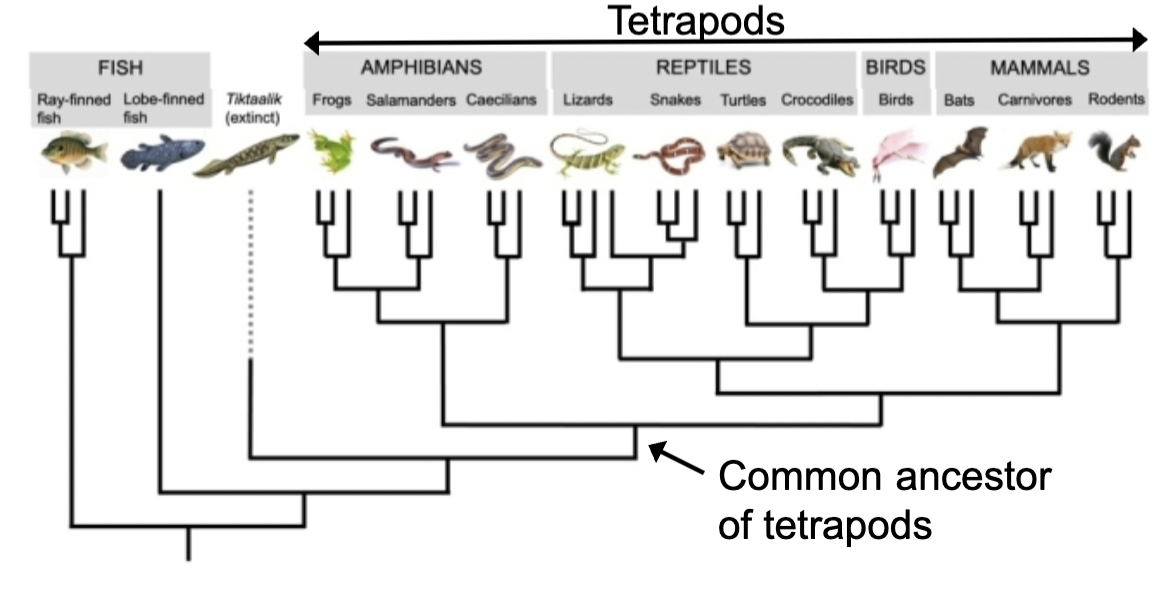Evolution and Phylogenies
1/18
There's no tags or description
Looks like no tags are added yet.
Name | Mastery | Learn | Test | Matching | Spaced |
|---|
No study sessions yet.
19 Terms
What are tetrapods?
they are a 4-limbed vertebrate lineage whose extant members include reptiles, mammals, amphibians, and birds (although not all extant tetrapods have 4 limbs, or any limbs)
What is the closest living relative to tetrapods?
Lobe-finned fish like coelacanth and lungfish
Are tetrapods descended from lobe-finned fish?
No, lobe-finned fish are the closest living relatives to tetrapods, but this does not mean we descended from lobe-finned fish, it means we share a recent common ancestor with them
What evidence is there for lobe-finned fish sharing a common ancestor with tetrapods?
Their anatomy of their fins shows that they are homologous to tetrapod limbs
What is the “missing link” between lobe-finned fish and tetrapods?
The Tiktaalik; it was an aquatic organism with long limbs and rudimentary wrist bones, but fins rather than toes; it also had a distinct neck that allowed it to move its head independently of its body; this does not mean that tetrapods are descended from Tiktaalik, only that we share a more recent common ancestor with them than we do with lobe-finned fish
Are lobe-finned fish more closely related to ray-finned fish or to tetrapods?
Lobe-finned fish are more closely related to tetrapods than to ray-finned fish because the most recent ancestor of the lobe-finned fish on this phylogeny is the same common ancestor they share with tetrapods

Homologous vs. Analogous characters
homologous characters are similar in two or more species because they were inherited from a common ancestor; analogous characters are similar in two or species, but evolved separately due to convergence; bird and bat wings are homologous as tetrapod forelimbs, but analogous as wings
What is used to group species in phylogenies?
Synapomorphies are used, which are derived characters that are shared by a group of species because it evolved in their common ancestor; species are NEVER grouped based on the retention of the ancestral state of a character; if something is a true synapomorphy, it will form a monophyletic group
What is a homoplasy?
Homoplasy refers to analogous characters that create the potential for the formation of an incorrect phylogeny; in order to be a homoplasy, the trait must have evolved multiple times independently, not just have been passed on from the ancestor; the retention of the ancestral trait is not considered homoplasy
What is a monophyletic group?
A branch of a phylogeny that includes the ancestor and ALL of its descendants; true synapomorphies will form monophyletic groups
What is an exaptation?
a trait that initially carries out one function and is later evolutionarily co-opted for another function; the original function may or may not be retained; an example of this is feathers and other traits that allow birds to fly; these traits evolved long before birds could fly, so it is thought that they originally evolved for other purposes and later became co-opted for flight
If a species is higher up on a phylogeny, does that mean that species is more primitive than species lower down on the phylogenies?
No. There is no such thing as any species being more “primitive” than another, we only classify characters (the states of the characters) as either primitive or advanced
What is parsimony relative to phylogeny?
Parsimony just means that the fewest number of steps is the most likely evolutionary scenario; the phylogeny with the fewest number of steps is the best one
What is a polytomy?
A polytomy is a point of uncertainty on a phylogeny where we are unsure about the exact order of branching often due to very quick branching of species; on a phylogeny, shorter branches means there is less data to support that branching, so it could be a mistake, while longer branches mean that there is a lot of data supporting that branching, so it is more likely that that is correct
What is incomplete lineage sorting?
This occurs when the evolutionary history of a gene differs from the evolutionary history of the species carrying that gene; this is due to the fact that mutations do not instantly go to fixation in a population, it can take millions of years for one allele to go to fixation, and during this time, species are branching off while the same mutation is still segregating, so it can make it look like certain species are more closely related than they are to other species when that may not be the case (this is an example of homoplasy)
How are Africans related to the rest of the populations of humans in the world?
All humans are descended from Africans, and a single lineage travelled out of Africa and radiated out to produce all other lineages in Europe, Asia, India, and the Americas; we know this because all non-African populations form a monophyletic group with East Africans; this also means that many Africans are more closely related to Europeans, Asians, Americans, etc. than they are to other Africans; Africa harbors a huge amount of genetic diversity
What does the evolution of HIV tell us?
HIV has evolved 4 separate times, twice from chimps and twice from gorillas, however ALL of these lineages independently evolved the same mutations; this is an example of molecular convergence and it could be mistakenly taken for a homology
Is evolution always a branching process that bifurcates into 2 new lineages at each node?
No, in microorganisms, horizontal gene transfer can occur, which is when genetic material is passed laterally from one existing bacteria to another; this can make the branching process look more like a web
What is reticulate evolution?
when two lineages interbreed and form a hybrid, and if that hybrid is viable it can have offspring, and a new lineage is formed; often occurs in bacteria